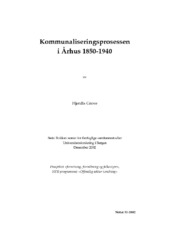| dc.contributor.author | Grove, Hjørdis | eng |
| dc.date.accessioned | 2006-06-22T08:38:19Z | |
| dc.date.accessioned | 2020-12-10T06:31:42Z | |
| dc.date.available | 2006-06-22T08:38:19Z | |
| dc.date.available | 2020-12-10T06:31:42Z | |
| dc.date.issued | 2002-12 | eng |
| dc.identifier.issn | 1503-0946 | |
| dc.identifier.uri | https://hdl.handle.net/1956/1410 | |
| dc.description.abstract | This paper discusses the relationship in conduct and organisation between private and municipal works in Århus, Denmark from 1850 to ca. 1940. It outlines the historical background of this Danish city community, where urbanisation and industrialisation define the further development, and continues discussing the local political framework throughout the period. Furthermore, tramways, gas and electricity and refuse disposal service are discussed in order to clarify the relationship between private and public organisation of works, and how and if this changed during the period in question. The private gasworks in Århus (1855) were built in a period when municipal gasworks were the rule in Denmark, but there already was a notable presence of private ones. Cities having private gasworks were not eager to municipalize merely for reasons of principle. When Århus acquired a municipal gasworks in 1880, this was due to the intervention of the local «Big Man» Hans Broge; an example of cooperation between private and municipal enterprise in the city. The electrical power stations in Denmark were municipalized at an early date. In Århus public opinion was from the beginning (1890) in favour of a municipal installation, although the first plans were private. When the electrical power station finally came about it was a municipal effort; almost as a natural consequence of the gasworks being controlled by the municipality. For the Århus tramways municipal ownership was from the beginning not an option. By the 1920’s the municipality had become a service institution and a large business manager, while municipal tramways had become the norm elsewhere in Denmark. Thus municipal ownership was both viable and politically desirable. The refuse disposal service was controlled by the municipality, but was farmed out to private entepreneurs. We observe that areas previously controlled by private enterprise gradually were taken over by the municipal authorities. The reasons for this can be found in the increasing urbanisation of society which led to changing practical needs that potentially could be met by technical innovations. In the rapidly growing city community the need for illumination and later, house-hold cooking, was met by the introduction of gas and electricity. New tramways took care of increased transport requirements, and refuse disposal service was organised in new and more efficient ways. | en_US |
| dc.description.abstract | Det blir her sett på tilhøvet mellom privat og kommunal forretningsdrift i Århus i Danmark for tida 1850 til rundt 1940. Innleiingsvis blir det gjeve eit overblikk over den historiske bakgrunnen til dette danske bysamfunnet, der urbanisering og industrialisering legg premissar for det vidare forløpet, og vidare over dei lokalpolitiske føresetnadene perioden igjennom. Områda sporvegstrafikk, gass- og elektrisitetsleveranse og renovasjon blir så gått gjennom for å få fram tilhøvet mellom privat og offentleg drift i den aktuelle perioden, og korleis dette eventuelt endra seg. Det private gassverket i Århus (1855) kom til i ein periode då kommunale gassverk dominerte i Danmark, men med private merkbart til stades. Byane som hadde private verk, var ikkje ivrige etter å kommunalisera av prinsipielle grunnar. Då Århus fekk eit kommunalt verk i 1880 skuldast dette «matadoren» Hans Broge si inngriping, eit døme på samspelet mellom offentlege og private krefter i byen. Når det gjeld elektrisitetsverka i Danmark blei desse temmeleg raskt kommunaliserte. I Århus var det frå byrjinga (rundt 1890) stemning for eit kommunalt verk, sjølv om dei første planane var private. Då elektrisitetsverket omsider kom, blei det kommunalt, nærast som ei følgje av at også gassen var kommunalt kontrollert. For sporvegen var kommunal eigarskap først ikkje eit reelt alternativ. På 1920-talet hadde kommunen blitt ein serviceinstans og eit stort forretningsområde, samstundes som kommunal sporvegsdrift hadde blitt vanleg andre stader. Såleis var kommunal eigarskap både tenkeleg og politisk ønskeleg. For renovasjonen sin del har det offentlege stått som øvste kontrollinstans alt før den behandla perioden, men arbeidet har vore sett ut til private. I Århus finn dermed vi frå midten av 1800-talet ein vekst i produksjonen av fellesgode under kommunal kontroll.Vi ser at kommunen i aukande grad tok over område som tidlegare var private. Forklaringa på dette ligg i hovudsak i den tiltakande urbaniseringa av samfunnet, som førte med seg behov som kunne fyllast av nye tekniske innovasjonar. I det raskt veksande bysamfunnet blei trongen for lys og kokevarme letta av gass og elektrisitet, behovet for transport blei hjelpt av sporvegen, og renovasjonen blei ordna på nye og meir effektive måtar. | no |
| dc.format.extent | 89532 bytes | eng |
| dc.format.mimetype | application/pdf | eng |
| dc.language.iso | nno | eng |
| dc.publisher | Stein Rokkan Centre for Social Studies | eng |
| dc.relation.ispartofseries | 31-2002 | |
| dc.relation.ispartofseries | Notat | no |
| dc.title | Kommunaliseringsprosessen i Århus 1850-1940 | nob |
| dc.type | Working paper | eng |
| dc.subject.nsi | VDP::Samfunnsvitenskap: 200 | nob |
